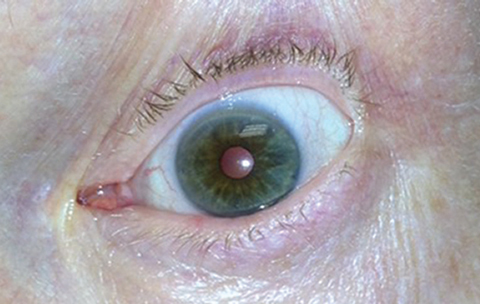 |
|
Study pinpoints risk factors of smaller pupils that should be accounted for during patient screening. Photo: Michael Trottini, OD, and Michael DelGiodice, OD. Click image to enlarge. |
A recently published study on the distribution of pupil size reported on several associated conditions, including diabetes, that they recommended clinicians take into account when examining patients.
“Sufficient pupil width is essential in ophthalmologic diagnostics to assess the periphery of the retina and to achieve adequate imaging quality in screening examinations, such as diabetic retinopathy screening,” the researchers wrote in their paper. They studied 18,335 eyes of 9,559 participants aged 40 to 80 in the Gutenberg Health Study cohort who had valid pupil size measurements.
Measurements included physical pupil diameter, central corneal thickness, corneal curvature, anterior chamber depth and axial length, as well as demographic information and medical history. They reported that the median pupil diameter was 4.19mm in patients’ right eyes and 4.12mm in left eyes. They also found that a smaller pupil was associated with older age, hyperopic refractive error, previous cataract surgery, diabetes, obesity and ACE inhibitor use, whereas wider pupils were associated with female sex, arterial hypertension, tricyclic antidepressant use and SNRI and tetracyclic antidepressant use. Smoking and socioeconomic status weren’t associated with pupil size.
Most prior studies of this sort have found no gender difference in pupil size, the authors noted, whereas this one showed (small) differences in male and female pupil size. “The results are at odds with previous publications and need to be clarified by future studies,” they acknowledged. One new finding the authors touted is the association with ACE inhibitors in their work, which was previously unknown.
The researchers concluded that the associated risk factors with smaller pupils—older age, hyperopia, ACE inhibitor use and diabetes—“should be considered when developing and assessing the feasibility of screening using nonmydriatic fundus photography, as a sufficiently large pupil is required to achieve adequate image quality, especially when aiming to use AI algorithms for screening.”
Kiel M, Grabitz SD, Hopf S, et al. Distribution of pupil size and associated factors: results from the population-based Gutenberg Health Study. Hindawi J Ophthalmol. September 9, 2022. [Epub ahead of print]. |


